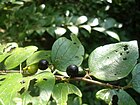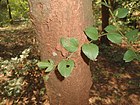Note: This is a project under development. The articles on this wiki are just being initiated and broadly incomplete. You can Help creating new pages.
Ziziphus xylopyra
Ziziphus abyssinica is a fiercely thorny, semideciduous plant, varying in habit from an erect shrub; a scrambling plant that clambers into other vegetation for support; or a tree with drooping branches that form a heavy, rounded crown. It usually grows from 3 - 12 metres tall. The bole is usually straight. The plant is harvested from the wild as a local source of food, medicines and other materials. It is sometimes cultivated as a stock-proof hedge.
Uses
Parts Used
Chemical Composition
The major chemical composition of Z. xylopyrus are rich in flavonoids in particular quercetin, quercitrin, kaempferol-4’-methylether and kaempferol, tannins (7.2%), d-7, 3’, 4’-trihydroxyflavan-3, 4-diol and oleanolic acid etc.[2]
Common names
| Language | Common name |
|---|---|
| Kannada | |
| Hindi | |
| Malayalam | |
| Tamil | |
| Telugu | |
| Marathi | |
| Gujarathi | |
| Punjabi | |
| Kashmiri | |
| Sanskrit | |
| English |
Properties
Reference: Dravya - Substance, Rasa - Taste, Guna - Qualities, Veerya - Potency, Vipaka - Post-digesion effect, Karma - Pharmacological activity, Prabhava - Therepeutics.
Dravya
Rasa
Guna
Veerya
Vipaka
Karma
Prabhava
Habit
Identification
Leaf
| Kind | Shape | Feature |
|---|---|---|
Flower
| Type | Size | Color and composition | Stamen | More information |
|---|---|---|---|---|
| {{{5}}} |
Fruit
| Type | Size | Mass | Appearance | Seeds | More information |
|---|---|---|---|---|---|
Other features
List of Ayurvedic medicine in which the herb is used
Where to get the saplings
Mode of Propagation
How to plant/cultivate
A plant usually of the drier areas of the hot tropics, where it can be found at elevations from 400 - 2,000 metres.[4]
Commonly seen growing in areas
Photo Gallery
References
- ↑ Indian Medicinal Plants by C.P.Khare
- ↑ Chemical constituents
- ↑ [Morphology]
- ↑ Cultivation
External Links
- Ayurvedic Herbs known to be helpful to treat Stomachache
- Ayurvedic Herbs known to be helpful to treat Snakebite
- Ayurvedic Herbs known to be helpful to treat Pneumonia
- Herbs with Fruits used in medicine
- Herbs with Leaves used in medicine
- Habit - Semi-deciduous shrub
- Index of Plants which can be propagated by Seeds
- Herbs that are commonly seen in the region of Scattered tree grassland
- Herbs that are commonly seen in the region of Combretum-Terminalia woodlands
- Herbs that are commonly seen in the region of Acacia woodlands
- Herbs






